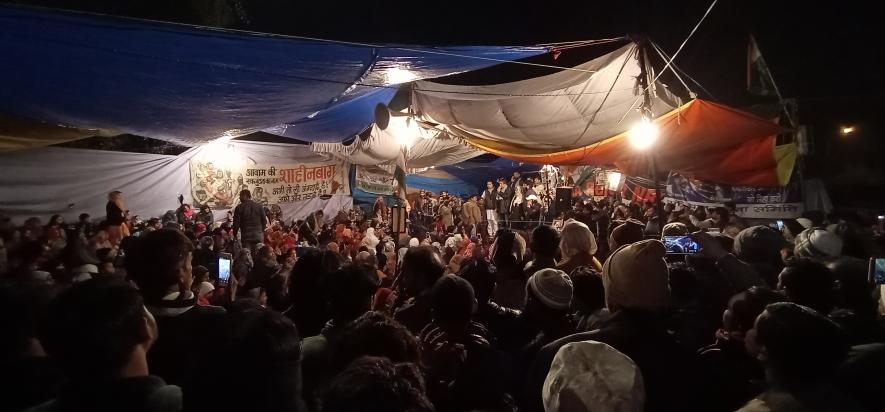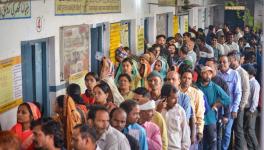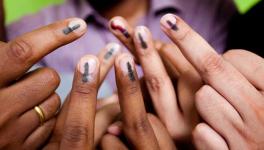Chakka Jaam: Legit for Sangh, Seditious for CAA Protesters

Chakka jaam or road blockade has been suddenly turned into an act of terror, courtesy the 17,000-page chargesheet filed by the Delhi Police in FIR 59/2020 relating to the February riots in Delhi. The chargesheet accuses a clutch of activists of organising chakka jaams in Northeast Delhi even though they thought these could trigger a Hindu-Muslim riot. But they still went ahead, the chargesheet argues, because they wanted violence to terrorise the Union government into rescinding the Citizenship Amendment Act—and, therefore, deserved to be booked under the Unlawful Activities (Prevention) Act.
Arguably of the same vintage as Indian democracy, chakka jaam is a tactics groups of citizens employ to pressure the state into entering dialogue with them. Implicit in the tactics is the warning: either the state listens to the woes of citizens or else it will have to countenance their disrespect and disobedience, of which chakka jam is designed to provide a glimpse.
Chakka jaams on a certain category of issues are routine—for instance, over price rise. Some issues have a greater relevance for a political formation than these have for others. Yet all political parties in India have deployed chakka jaam as a tactics to have the concerns of their supporters addressed by the state. Not least the Rashtriya Swayamsevak Sangh and its affiliates, including the Bharatiya Janata Party, which is now in power.
The Sangh, in its defence, will claim that its chakka jaams did not lead to violence, at least of the scale witnessed in Delhi in February. It can very well be argued that the Sangh’s chakka jams did not erupt because the government entered into dialogue with its leaders and pacified them. Or that people were not mobilised to violently disrupt the Sangh’s chakka jaams.
Chakka jaam on Ram Setu
Take the 2007 controversy over the Sethusamudram shipping canal project, which entailed the dredging of the sea that would have destroyed a chain of limestone shoals, mythologised as Ram Setu, the bridge Ram is said to have built to go to “Lanka” and rescue Sita from Ravana. The project was challenged in the Supreme Court. In September 2007, the United Progressive Alliance government filed an affidavit, which had been vetted by the Archaeological Survey of India, to say that there was no scientific and historical evidence to prove the existence of Lord Ram or Ram Setu.
The affidavit prompted the Vishwa Hindu Parishad to call for a three-hour countrywide chakka jaam on 12 September. National dailies reported traffic snarls in Delhi and Mumbai. Much of Madhya Pradesh was paralysed. Around 15 roads in Bhopal were blocked. A media report said, “Police personnel deployed to maintain law and order did not come forward to help the people though the VHP leaders had announced that essential services would be left untouched.” This was presumably because the BJP was ruling the state then.
Road blocks prevented a pregnant woman in labour to reach a government hospital. She delivered on the roadside, triggering a light-hearted debate whether the child should be named “Ram” or “Jaam.” In Giridih, Jharkhand, clashes broke out between VHP men and those opposed to the chakka jaam. Rail traffic was disrupted in Bihar, for which Nitin Navin, a BJP legislator and 200 of his activists were taken into custody. In those three hours, archival material shows that large parts of north India either came to a grinding halt or crawled.
The UPA government’s response to the chakka jaam was swift—it announced it would withdraw the affidavit, suspended two ASI officials held responsible for not heeding then Culture Minister Ambika Soni’s order to delete references to Ram and the Ram Setu from the affidavit. Soni, in fact, offered to resign. Peace was restored.
The Sangh claimed victory and, yes, lavishly praised its activists for their robust participation in the chakka jaam. For instance, the Organiser, the official organ of the RSS, wrote in its edition dated 18 November 2007: “The Akhil Bharatiya Karyakari Mandal [the executive council of the RSS] congratulates our society at large, the youth in particular, and various social and cultural organisations for extending unprecedented and massive support to the countrywide Chakka Jaam programme… and making the programme a historic success.”
For the Sangh, a successful chakka jaam was worth a boast. Speaking at a public rally in September, Union Minister Purushottam Rupala, who was then the BJP State party chief, said, “If we had not organised a chakka jaam, the Centre would not have retracted their statement about Lord Ram.” On the dais was also Prime Minister Narendra Modi, who was then the Gujarat chief minister. He mocked UPA leader Sonia Gandhi, saying she could not understand Indian religion as she was born in Italy.
It is indeed a sign of robust democratic culture for the state to respond to chakka jaam, either through an offer of dialogue or by removing the cause that provokes people to block roads. (The Sethusamudram project still remains stalled. In July this year, DMK leader TR Baalu requested Modi to revive the project.)
Chakka jaam on Amarnath yatra
Negotiation was also the route the UPA government adopted to defuse the social tension trigged, in 2008, by what is now remembered as the Amarnath Land Transfer controversy. On 26 May 2008, around 100 acres of land were transferred to the Shri Amarnath Shrine Board (SASB), to construct facilities for pilgrims visiting the Amarnath caves. The Valley erupted. Under pressure, the transfer of land was cancelled on 29 June.
It was now the turn of the people of Jammu to protest, which was organised under the umbrella of the Sri Amarnath Shrine Yatra Sangharsh Samiti (SAYSS). Bandhs, marches and rallies became the norm for weeks on end. Curfew was imposed in several towns, and the army was deployed on the highways, on 2 August, to ensure safe passage to trucks ferrying essential commodities to Srinagar.
On 13 August, the VHP and the BJP organised a two-hour countrywide chakka jaam, between 9 am and 11 am, for the restitution of land to the Amarnath Shrine Board. A media report said, “The blockade was tactically done for only two hours in the morning to affect officer-goers.” The report also stated that “road and railway traffic were disrupted across several States.”
In Ahmedabad, the police allowed VHP activists to block Paldi square for 45 minutes. Guess who was present there? A media report said, “BJP MLA Rakesh Shah and ex-Mayor of Ahmedabad Amit Shah were present here. However, they did not actively participate in the agitation, they stood at some distance from the event…” About the 13 August chakka jaam, Narender Sehgal, in his book, The Victory of Faith: United Hindus Make Strong India, writes, “This call had enormous effect and the response was overwhelming. Lakhs of people took part in this peaceful chakka jaam….”
Sehgal’s take on the jaam was perhaps a case of hyperbole. But the chakka jaam, organised by SAYSS in Jammu province on 25 August, was resoundingly effective. In Digiana and Kathua, around 15 people were injured in clashes with the police. Through the weeks of protests, the protesters targeted trucks plying to and from Srinagar, leading many to talk about the economic blockade of the Kashmir Valley. This the government denied, but other media outlets put out figures to show a very sharp dip in traffic on the Jammu-Srinagar highway.
On 11 August, in fact, thousands of traders in the Kashmir Valley took to the highway going to Pakistan, with trucks of farm produce they said would rot because of the economic blockade. The police opened fire on protesting traders, killing four. Another 180 were injured and some 100 people were taken into custody. On 12 August, Hurriyat leader Mirwaiz Umar Farooq said, “I think the blockade made people realise that Kashmir at the moment totally depends on India and that we need to be economically independent.”
Farooq’s remark shows that the chakka jaam on the Amarnath land issue had serious security implications, apart from adversely affecting Kashmir’s economy. Yet, even as the people vented fury, the government negotiated with the leaders of the agitation. Peace was restored as a deal was struck, on 31 August, between the government and the SASB, which granted 40 hectares of land to the latter for its exclusive use during the yatra period. The SAYYYS called off the two-month-long agitation.
Sangh’s hypocrisy
The UPA government’s handling of the Amarnath controversy is in sharp contrast to the Union government’s approach to the anti-CAA protests in Delhi. A brutal crackdown was ordered on a protest march of Jamia Millia Islamia students in Delhi, prompting the women of Shaheen Bagh to occupy a part of the road linking Delhi to NOIDA, Uttar Pradesh. They stayed on the road for weeks, night and day, braving the winter chill, consciously hushing anyone who tended to adopt a radical or violent language, and always harped on the Indian Constitution guaranteeing equal citizenship to all. And they, unlike those in Jammu, did not resort to violence.
Yet their impeccable conduct did not soften the Union government into opening negotiations with the anti-CAA protestors. They were, in the weeks before the Delhi Assembly elections, demonised and projected as traitors. The government’s refusal to offer an olive branch to them seemed to have prompted the more impatient and radical elements to intensify their stir—and organise chakka jaams.
Chakka jaam is a legitimate political tool, which the Sangh too has employed in the past. It is facetious to claim that those chargesheeted in FIR 59 were prima facie guilty because they were aware that their chakka jaams could invite a violent reaction. The blame lies on those who conspired to perpetrate violence, not on the activists who planned a road blockade. They did not deserve to be booked for terror, as were not the Sangh leaders who organised chakka jaams on the Ram Setu and Amarnath issues.
The author is an independent journalist. The views are personal.
Get the latest reports & analysis with people's perspective on Protests, movements & deep analytical videos, discussions of the current affairs in your Telegram app. Subscribe to NewsClick's Telegram channel & get Real-Time updates on stories, as they get published on our website.
























